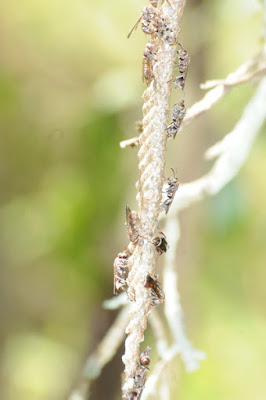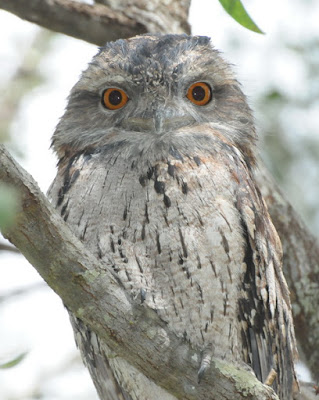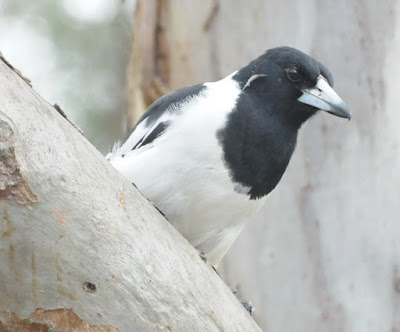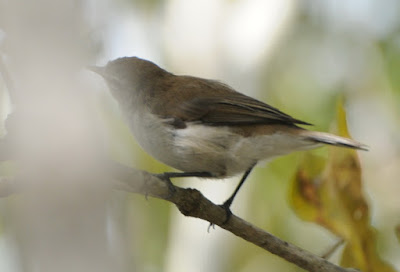April 9, 2011, was our last day in Brisbane. During my two-year stint in Australia in 1972-74 (not to mention two earlier visits) I had built up a pretty substantial bird list, but there was one more or less common Brisbane bird that had eluded me: the Mangrove Honeyeater (Lichenostomus fasciogularis). I now had one last chance to find it, so Sue's son Lawrence drove me out to two coastal reserves northeast of town where the bird should have been: Boondall Wetlands, the largest wetland site in the Brisbane area (and a site listed under the Ramsar Convention), and nearby Tinchi Tamba. Like the Coombabah Wetlands I described in my last post, both areas have bands of saltmarsh separating the mangroves from swamp-oak woodlands at the highest tide level; this photo shows Tinchi Tamba, where the mangroves are more accessible.
At Boondall a local volunteer guide took us around a circular trail. He was very knowledgeable about the local insect fauna, and pointed out some of the local dragonflies. This one is a Red Swampdragon (Agrionoptera insignis allogenes).
Even redder is this Wandering Percher (Diplacodes bipunctata).
A third red dragon - a Fiery Skimmer (Orthetrum villosivittatum).
A nice example of camouflage: an Evening Brown Butterfly (Melanitis leda).
Usually we think of butterflies as more striking than moths, but in a contest between the Evening Brown and this day-flying moth (Nyctimera secundiana) a member of the family Arctiidae, the moth would probably win.
I felt a bit nervous photographing this Australian Hornet (not really a hornet) or Large Mud-nest Wasp (Abispa ephippium), one of a number of large Australasian potter wasps. Doing so brought back memories of a day in 1973 when I got just a bit too close while trying to photograph a squadron of equally-colourful paper wasps sitting on their nest in northern Queensland.
As I looked through the viewfinder I was treated to the sight of the wasps rising from the top of the nest like attack planes from an aircraft and flying purposefully in my direction. Think of the helicopters in Apocalypse Now. I dropped my gear and ran for it, but managed to be stung several times nevertheless. For the next few days I looked like a beached dirigible, felt particularly ill, and spent much of my time vowing never to photograph wasps again (a promise I have obviously broken here).
I've broken it here, too, but the Brown Paper Wasp (Ropalidia revolutionalis) is a non-aggressive little thing (it's only about 10 mm long). I only found out later that they can deliver a nasty sting. Anyway, its nest is most peculiar - a long string-like comb, two cells across, that I at first mistook for a misshapen twig.
This wasp is one of some 200 Ropalidia species, distributed throughout the warmer parts of the Old World.
Trolling for all these insects is this female Coastal Golden Orb Weaver (Nephila plumipes), accompanied by her tiny mate.
On to the birds: first, an Australian Pelican (Pelecanus conspicillatus), handsomest (as I argued in an earlier post) of the world's pelicans.
In my last post I showed you one Tawny Frogmouth (Podargus strigoides) in rather dim light; here are two in bright sun that our guide showed us at Boondall Wetlands. They really do have orange eyes.
Frogmouths, though they look rather like one of the scruffier muppets, are active predators, pouncing by night on everything from insects to lizards and mice.
Despite their owl-like appearance, they are actually giant nightjar relatives that hunt from a perch rather than on the wing (making them ecological equivalents of the potoos of he New World tropics). Now I will have to turn up one of their Malaysian relatives (in the related genus Batrachostomus, composed entirely, as far as I am concerned, of jinx birds).
This Pied Butcherbird (Cracticus nigrogularis) greeted us as we arrived at Tinchi Tamba in a last attempt to see a Mangrove Honeyeater.
Butcherbirds are the ecological equivalents of shrikes in Australia, and like them they use larders to store their prey for later use. Instead of impaling prey items on thorns, as shrikes do, Butcherbirds are more likely to wedge them into a fork or crevice, as this bird is doing (I was not able to get a clear look at what, exactly, it was taking away).
The bird I was looking for is not the only mangrove specialist in Australia. This is a poor shot of another, the Mangrove Gerygone (Gerygone levigaster). It does range a bit beyond the mangroves, but its coastal range, pretty much paralleling the range of mangroves in Australia, is evidence of its preference.
Finally, though, the bird of the hour put in an appearance (coaxed, I confess, by a tape). It is quite a handsomely-marked creature, even though its only touch of bright colour is the yellow streak across its face (if you don't count it's blue eyes).
The Mangrove Honeyeater is a much more localized bird than the Mangrove Gerygone, confined to a coastal strip from central Queensland south to northern New South Wales. Brisbane lies in the heart of its range, and I was glad to catch up with it there at long last!






















No comments:
Post a Comment